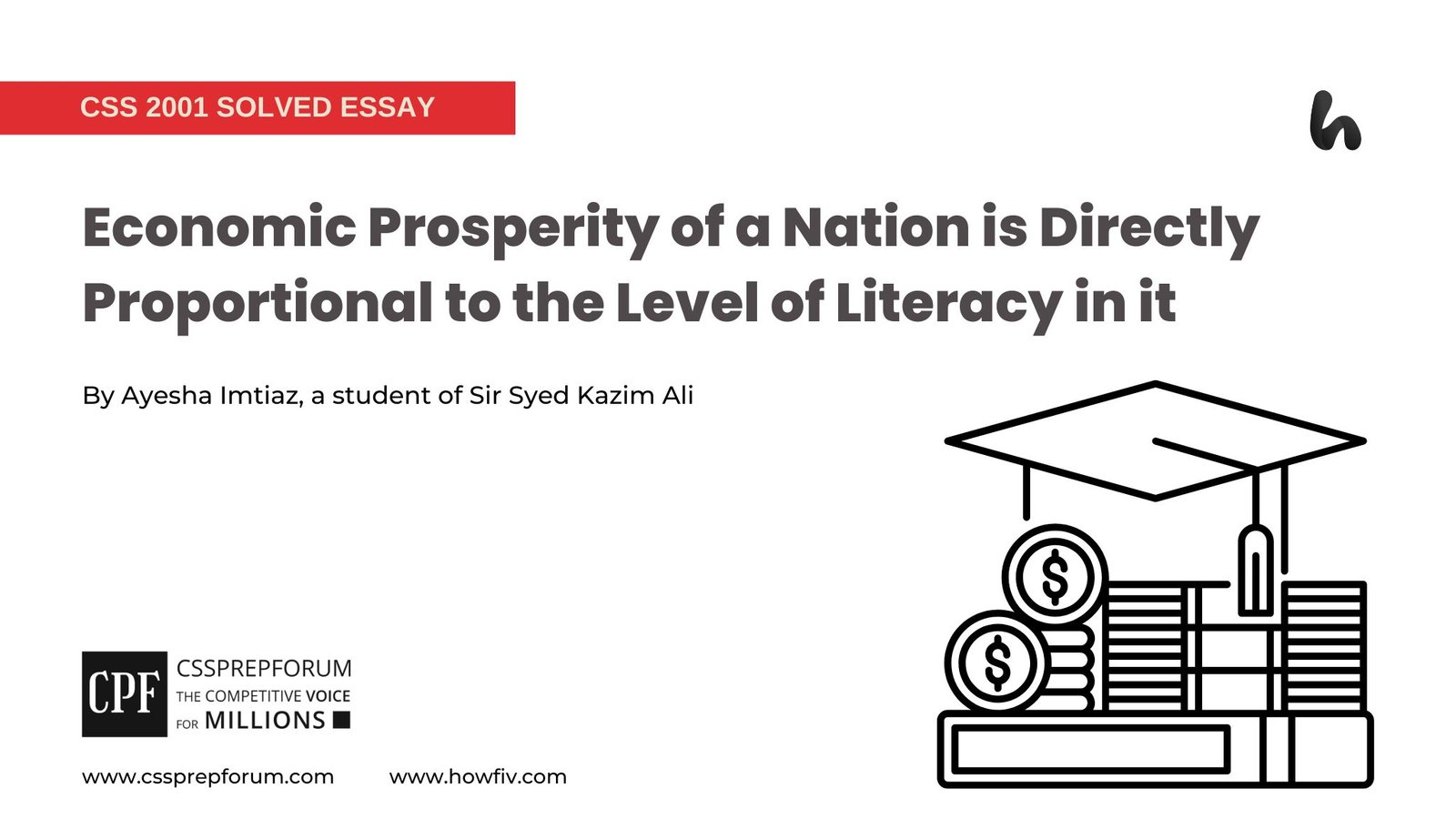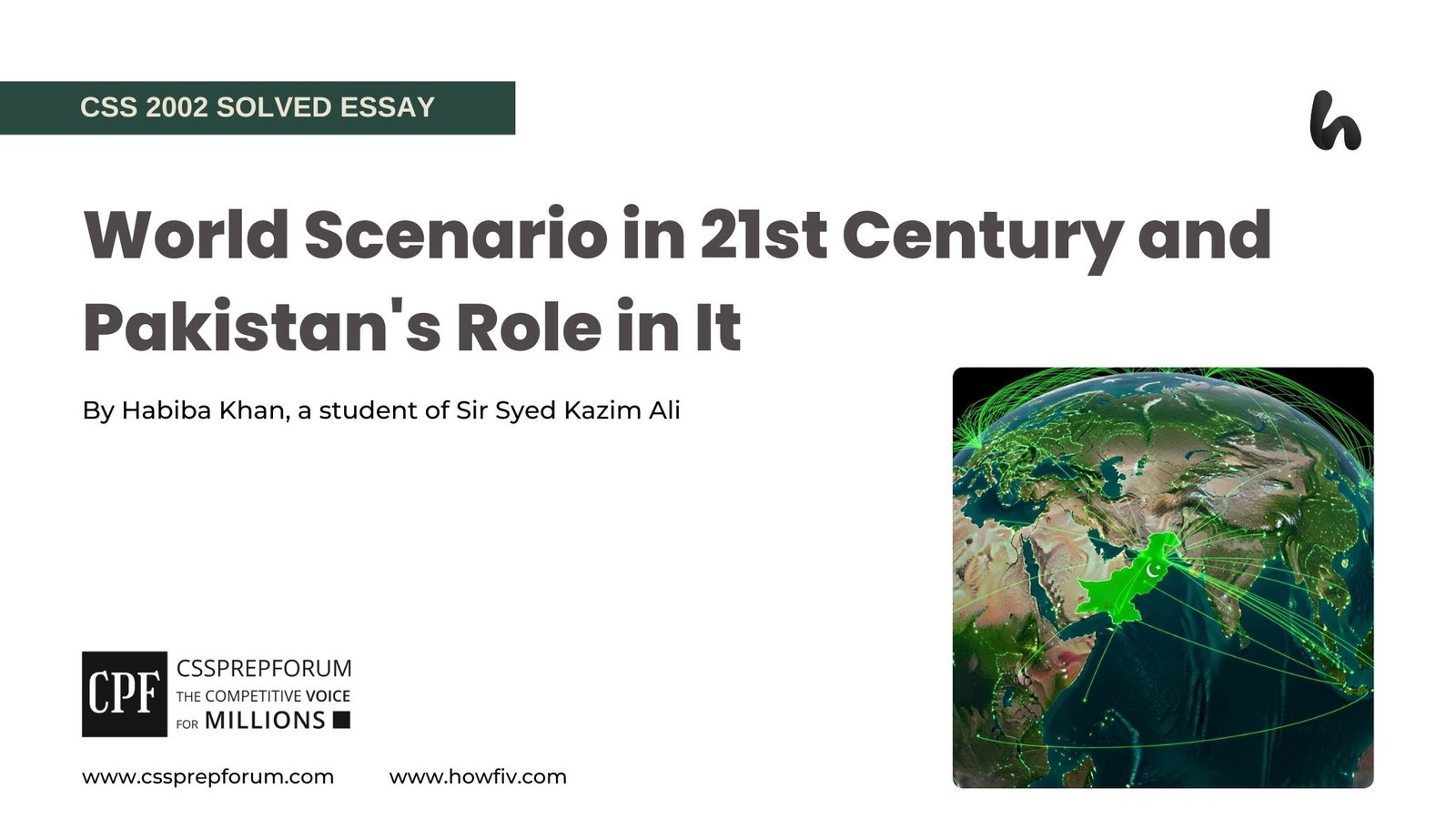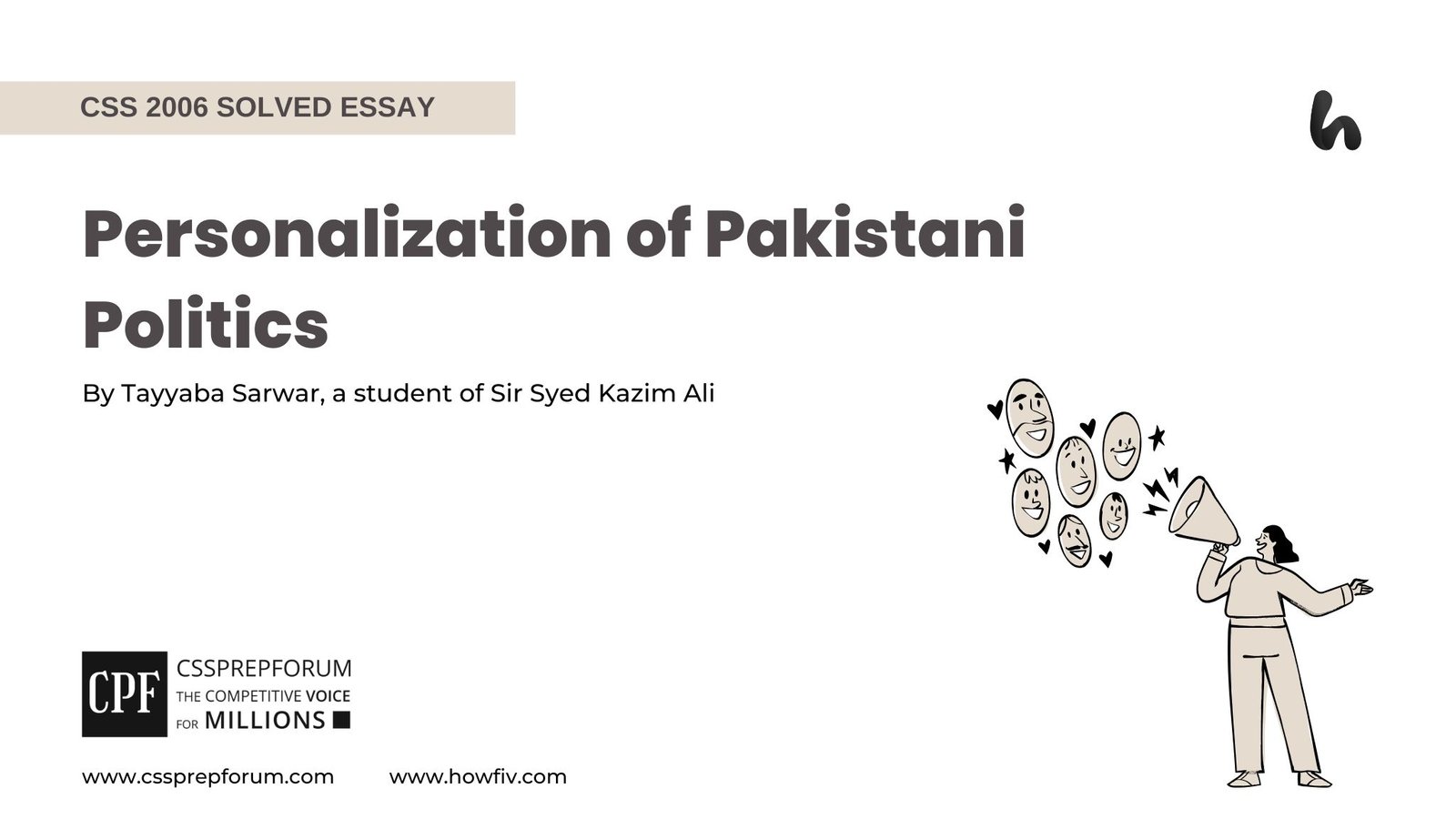CSS & PMS Pakistan Affairs | Options For Pakistan to Resolve the Kashmir Issue
The following question of CSS Pakistan Affairs is solved by Aqsa Noor under the supervision of Howfiv’s Pakistan Affairs and Current Affairs Coaches: Miss Iqra Ali and Sir Ammar Hashmir. She learnt how to attempt 20 marks question and essay writing from Sir Syed Kazim Ali, Pakistan’s best CSS and PMS English essay and precis teacher with the highest success rate of his students. This solved question is attempted on the pattern taught by Sir to his students, scoring the highest marks in compulsory and optional subjects for years.

Outline
1-Introduction
2-Historical Background of the Kashmir Issue
3-Suggestions for Pakistan to resolve the Kashmir issue once and for all
- ✓Reviving Bilateral Dialogue between Pakistan and India
- ✓Encouraging implementation of Confidence-Building Measures (CBMs)
- ✓Involving Kashmiris in Negotiations
- ✓Taking Steps to Demilitarize the Region
- ✓Encouraging International Mediation
- ✓Autonomy-Based Solutions
- ✓Vocalizing Human Rights Concerns in IIOJK
- ✓Proposing four points solution
4-Critical Analysis
5-Conclusion

Answer to the Question
Introduction
Pakistan and India share a complex history of seven decades full of hostile and volatile relations characterized by persistent ups and downs. The strained relations between the two are due to multipronged conundrums, but the disputed issue of Kashmir, universally recognized as the nuclear flashpoint, and a serious International security issue. The pages of history are full of direct kinetic wars over the Kashmir issue, worsening the situation every time. Kashmir has been chained in a maze of complications but all hope is not lost, as the wars were followed by diplomacy and problem-solving mechanisms, such as the implementation of confidence-building measures and peace talks, such as Shimla Agreement 1972 and Lahore Resolution 1999. Therefore, there’s a beam of light which encourages the people of Kashmir that they will be liberated from Indian illegal oppression, and live a peaceful life.
Historical Background of the Kashmir Issue
The Kashmir issue has been a flashpoint between the two nuclear-armed states since 1947. The issue has evolved over time and has taken serious turns due to the ambiguous and unilateral decision of Maharaja Hari Singh. At the time of partition, Jammu and Kashmir was one of the 562 princely states under British India. It was given the choice to join India or Pakistan or to remain independent. While British India was divided into India and Pakistan, Kashmir was a majority Muslim state which was ruled by a Hindu Maharaja Hari Singh. Maharaja was reluctant to join either Pakistan or India. However, in October 1947, armed tribal forces from Pakistan entered Kashmir. Resultantly, Hari Singh sought help from India, and signed the Instrument of Secession on October 26, 1947, acceding Kashmir to India. This very act led to the First India-Pakistan War in 1947-48. Moreover, India referred the issue to the United Nations. UN Security Council called for a ceasefire, demilitarization of the region and a plebiscite in Kashmir. However, India has never accepted the resolution and Kashmiris right to self-determination, leading to several skirmishes over the decades.
Suggestions for Pakistan to resolve the Kashmir issue once and for all
- Reviving Bilateral Dialogue between India and Pakistan
Reviving bilateral dialogue between India and Pakistan is the need of the time to resolve long long-standing issue of Kashmir. New Delhi and Islamabad have gone through such dialogues, such as the Shimla Agreement 1972, and the Lahore Resolution 1999, where both resolutions aimed to find a bilateral solution to the Kashmir issue. It was, however, successful in achieving short-term peace plans, but failed to get bigger milestones due to the trust deficit created as an aftermath of the Kargil war and the Mumbai attacks. Despite the issue, it is of paramount importance to realize that bilateral dialogues can be restored with mutual respect and trust between both countries. Thus, the stability of Kashmir is a strategic need of two nuclear powers.
- Encouraging Implementation of Confidence-Building Measures (CBMs)
Confidence-building measures CBMs between India and Pakistan play a crucial role in resolving hostilities and fostering peace in the region. There have been several CBMs involved in history, such as an agreement on non-attack on nuclear facilities, composite dialogues (2004-2008), Cross LOC trade (2008), and many others. However, the trust deficit was created again after the Mumbai and Pulwama Attacks. Nevertheless, both countries must make efforts to initiate military, political, humanitarian, cultural and economic CBMs again to stabilize the region. Thus, this way New Delhi may stop using the pretext of Kashmir to wage war against Pakistan.
- Involving Kashmiris in Negotiations
Involving Kashmiris in Negotiations is crucial to achieve long-lasting peace, social and political stability, and economic sustainability. However, in previous talks, Kashmiris’ representation was missing in the peace talks. Moreover, being a custodian of Kashmir Land, it is their inherent right to decide their fate and freedom. Moreover, any decision made by India and Pakistan without considering the Kashmiris will be a mere imposition of a decision made by two sovereign states. Thus, the Kashmir issue deserves a thaw in the cold and stiff relations of India and Pakistan, to achieve long-term prosperity in the region.
- Taking Steps to Demilitarize the Region
Demilitarization of the Kashmir region is one most significant steps to de-escalate tensions, and to foster peace in the region. Kashmir is considered a heavily militarized zone in the world. Moreover, India has deployed 130,000 army personnel, brutally limiting their rights to movement and freedom, particularly in Indian Illegally Occupied Jammu and Kashmir. The provocative act by India has exacerbated the cross-border violations, human rights abuses, and political and economic instability in the region. Additionally, the ceasefire agreement of 2003 significantly improved the ties and eased the tensions on both sides. Resolution 96 of the United Nations emphasized demilitarization to facilitate a peaceful settlement. At present, however, revocation of Article 370 by the Indian Government, and its heavy military presence in IIJOK have significantly raised the concerns. On the contrary, Pakistan has been advocating for the cause of Kashmir. Thus, the demilitarization of the region is the need of the hour to ensure peace and security.

- Encouraging International Mediation
Moving down the ladder, encouraging international mediation is another viable option to resolve the Kashmir issue. Though Pakistan and India have been through several diplomatic engagements, but failed to achieve long-lasting peace. Moreover, Pakistan has been supporting the Kashmir cause for seven decades now, and has raised the issue on international forums, such as the United Nations General Assembly and the Human Rights Council. India, on the contrary, has always opposed the mediation, calling it a bilateral matter. However, mediation provides humanitarian, legal and diplomatic solutions. Therefore, International mediation provides a comprehensive strategy to long-standing issues, ensuring peace in South Asia.
- Autonomy-Based Solutions
The autonomy-based resolution is one of the most significant steps in the Kashmir history, as both countries can consider Andorra model to resolve the current dispute, which requires them to reconstitute part of Jammu and Kashmir as a sovereign entity, with free access to and from both sides of its large neighbors. Moreover, the reconstituted part would have its own secular democratic constitution, distinct citizenship, a flag, and legislatures, which would pass laws on all matters other than defense and foreign affairs, changing nothing in the LOC, but the whole zone will be demilitarized. Additionally, the autonomous model would allow the Kashmiris to pursue their aspirations as an independent nation. Thus, the autonomous status of Kashmir can only be achieved through confidence and trust-building measures among Pakistan, India and Kashmir, guaranteeing their right to live a free life.
- Vocalizing Human Rights Concerns in IIOJK
Addressing human rights concerns in IIOJK is crucial to highlight the mass killings and genocide in Kashmir by the Modi government over the years. The revocation of Article 370 in August 2019 is an infringement of international law, which has further intensified the situation. Moreover, censoring media imposing restrictions on movement, militarization, blackouts, and planned attacks within the region are the sheer examples of extrajudicial killings, enforced disappearances, torture, and injustice by the Hindutva government. According to the Office of the UN High Commissioner for Human Rights (OHCHR) Reports of 2018 and 2019, India has committed “serious human rights violations. Additionally, Amnesty International and Human Rights Watch have been subsequently condemning the aggressive use of Hindutva policies. Thus, impartial investigations into Kashmir attacks such as the Pulwama and Pahalgam attacks are the need of the hour to address human rights concerns in the region. Moreover, alleging Pakistan without evidence shows the non-serious and oppressive attitude of the Modi government towards Kashmiri sentiments in Pakistani nations.

- Proposing four points solution
Musharraf purposed four-point solutions for the Kashmir dispute, such as withdrawal of troops. Second, no significant change in the border of Kashmir, third, giving them right to self-govern without independence. Last, a joint the supervision mechanism in Jammu and Kashmir, involving India, Pakistan and Kashmir. The formula suggests a comprehensive framework for the Kashmir future, indicating self-rule and peaceful coexistence of Kashmiris in the region. Thus, this formula may pave the way for prosperous and stable Kashmir.
Critical Analysis
Despite the above-mentioned suggestions, Pakistan can only do a little unilaterally to resolve Kashmir issue. The main reason that is halting the resolution of Kashmir issue is the aggressive policies of Indian government, particularly their right-wing agenda in the Indian Illegally Occupied Jammu and Kashmir (IIOJK), such as unilateral revocation of Article 370. Furthermore, India’s repeated allegations against Pakistan of the State-sponsoring terrorism, for instance Pulwama Attack and Pahalgam Attack have hindered the two countries to initiate bilateral dialogues on contentious issue. However, Pakistan must continue to engage in bilateral dialogues and confidence-building measures, while encouraging autonomy-based solutions for Kashmir. Moreover, to counter Indian aggressive policies, it is crucial to internationalize the Kashmir issue, such as addressing human rights concerns and the right to self-determination at International platforms, for instance Organization of Islamic Cooperation (OIC) and United Nations (UN), where Muslim countries must support the Kashmir cause, resolving the conflict once and for all.
Conclusion
Kashmir issue has been a bone of contention between the two nuclear states, highlighting the severe skirmishes and direct military confrontation over the years. The complex history of Kashmir has witnessed a number of highs and lows from losing innocent and civilian lives to losing special autonomous status after revocation of articles 370 and 35A. However, a beam of lights still exists in the form of international organization, such as the United Nations has intervened a number of times, and passed resolutions in favor of Kashmir. Moreover, there are several breakthroughs to resolve long-standing disputes, for instance initiating bilateral dialogues, addressing human rights concerns, and implementing CBMs can significantly improve the ties of Pakistan and India with respect to Kashmir issue. Therefore, Pakistan must accelerate the efforts and internationalize the cause to amplify the voices of Kashmiris.

CSS Solved Past Papers’ Essays
Looking for the last ten years of CSS and PMS Solved Essays and want to know how Sir Kazim’s students write and score the highest marks in the essays’ papers? Then, click on the CSS Solved Essays to start reading them.
CSS Solved Essays
CSS Solved Islamiyat Past Papers
Want to read the last ten years’ Islamiyat Solved Past Papers to learn how to attempt them and to score high? Let’s click on the link below to read them all freely. All past papers have been solved by Pakistan’s top CSS Islamiyat coaches having the highest score of their students.
CSS Solved Islamiyat
CSS Solved General Science & Ability Past Papers
Want to read the last ten years’ General Science & Ability Solved Past Papers to learn how to attempt them and to score high? Let’s click on the link below to read them all freely. All past papers have been solved by Pakistan’s top CSS GSA coachez having the highest score of their students.
CSS Solved General Science & Ability
CSS Solved Pakistan Affairs Past Papers
Want to read the last fifteen years’ Pakistan Affairs Solved Past Papers to learn how to attempt them and to score high? Let’s click on the link below to read them all freely. All past papers have been solved by Pakistan’s top CSS Pakistan Affairs coaches having the highest score of their students.
CSS Solved Pakistan Affairs
CSS Solved Current Affairs Past Papers
Want to read the last fifteen years’ Current Affairs Solved Past Papers to learn how to attempt them and to score high? Let’s click on the link below to read them all freely. All past papers have been solved by Pakistan’s top CSS Current Affairs coaches having the highest score of their students.
CSS Solved Current Affairs












